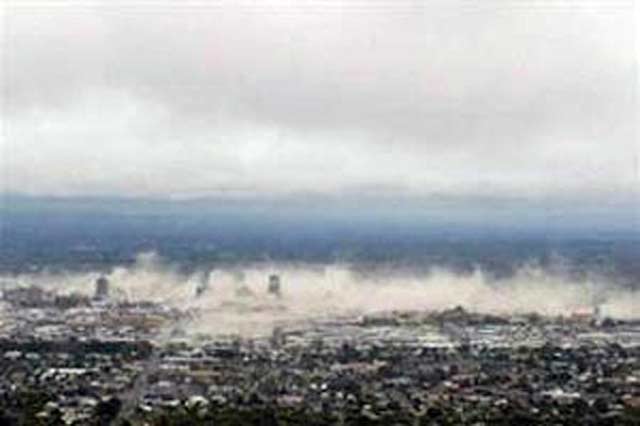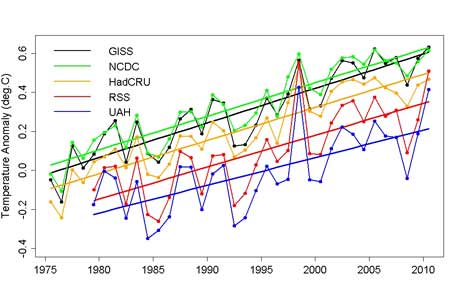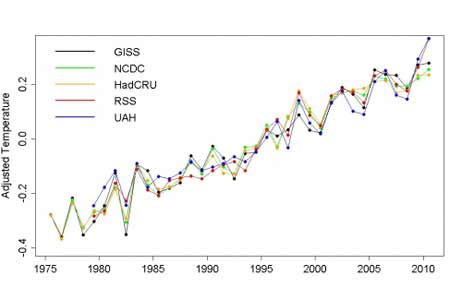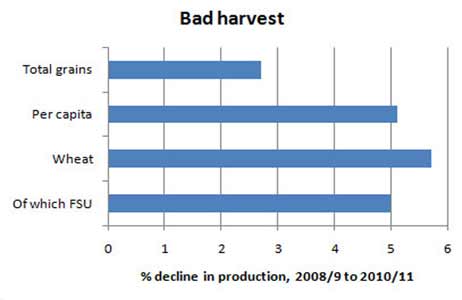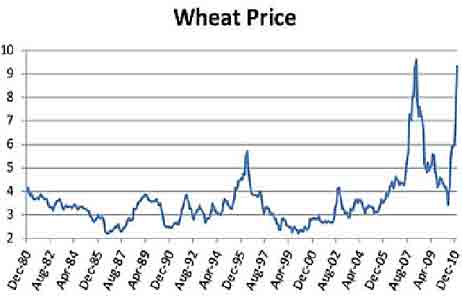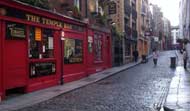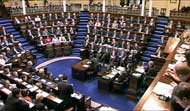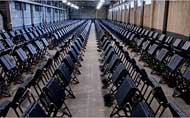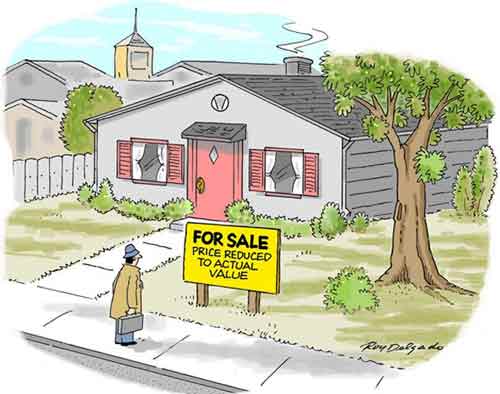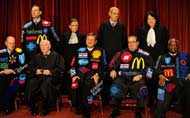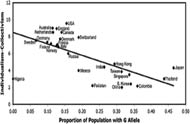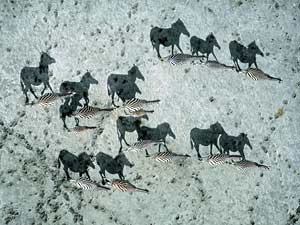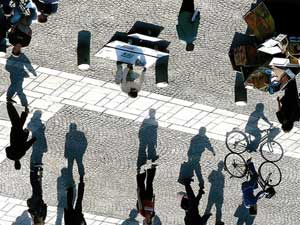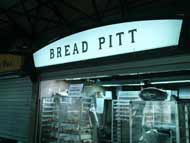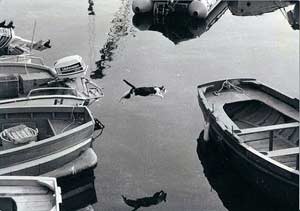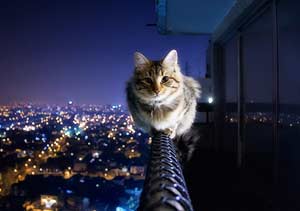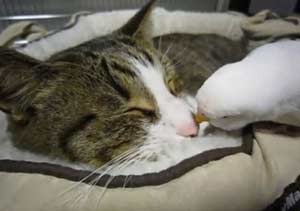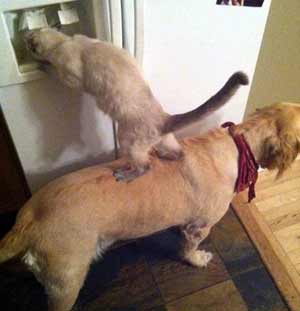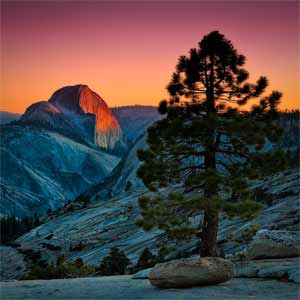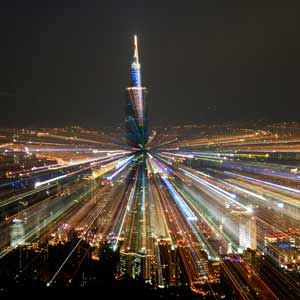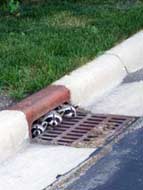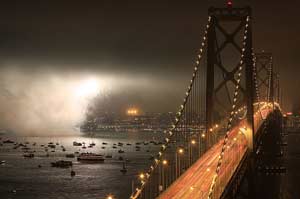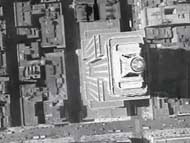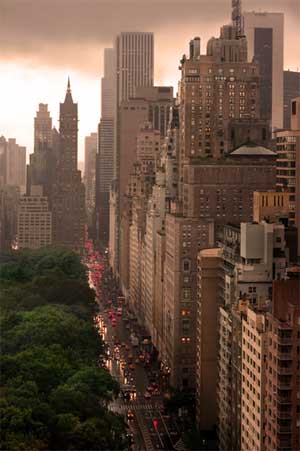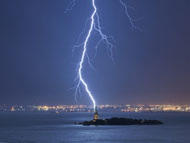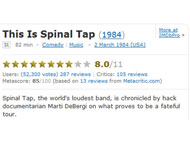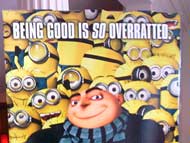This is what an earthquake looks like. This was Christchurch, NZ.
Corporations have been enthroned and an era of corruption in high places will follow.
The money power of the country will endeavour to prolong its reign by working upon the prejudices of the people
until all wealth is aggregated in a few hands and the Republic is destroyed.
Thripsis
Feb. 28, 2011
- How fast is Earth warming? What do the uncompensated data look like? Upper left are all 5 records (annual averages with trend lines) from 1975 to the present (the satellite records don’t start until about 1979). Next, current known natural influences are subtracted. The Multivariate el Niño Index (MEI) is used to characterise el Niño and the Volcanic Forcing Data to characterise volcanic influence. An annual cycle in the data is simulated by including a 2nd-order Fourier fit characterising solar fluctuation by the international sunspot numbers. A lag in the influence of el Niño, volcanic forcing, and sunspot numbers has been allowed. Removing the estimated impact of all these leaves the global warming trend shown at the upper right and any remaining natural variation. This annually-averaged, adjusted, dataset includes all 5 climate data sources. Presently, Earth is warming at about 1.7º C per century. There is reason to believe that it may warm even faster in the upcoming decades.
- What’s behind the surge in food prices? Some kinds of demand are growing faster than the population — in particular, China is becoming a growing importer of feed to meet their demand for meat. But the demand for grain is highly price-inelastic: it takes big price rises to induce people to consume less. Most of the decline in world wheat production, and about half of the total decline in grain production, has taken place in the former Soviet Union — mainly Russia, Ukraine, and Kazakhstan — due to an incredible, unprecedented heat wave and drought, which pushed Moscow temperatures above 100ºF (37.8ºC) for the first time ever. The Russian heat wave was only one of many recent extreme weather events, from dry weather in Brazil to biblical-proportion flooding in Australia, that have damaged world food production. To some extent it’s the result of a natural phenomenon, La Niña — a periodic event in which water in the equatorial Pacific becomes cooler than normal. La Niña events have historically been associated with global food crises. Don’t let unusual northern-hemisphere snow fool you: globally, 2010 was tied with 2005 for warmest year on record, even though we were at a solar minimum and La Niña was a cooling factor in the second half of the year. Temperature records were set not just in Russia but in no fewer than 19 countries, covering 1/5th of the world’s land area.
- Someone has to consume less, and it will be the people at the bottom of the economic ladder, in this case the poorer Arabs. Every so often the wheat price is likely to go through the ceiling, as it did during the past 12 months. To make life intolerable for the Arab poor, the price of wheat does not have to remain high indefinitely; it only has to trade out of their reach once every few years. Financial crises, like epidemics, kill the unhealthy first. The present crisis is painful for most of the world but deadly for many Muslim countries, and especially so for the most populous ones. Speculators can see that wheat is going to be more expensive in the future than it is now. So, they buy and store it. This reduces consumption now. (People really do respond to incentives. A higher price for wheat today means less wheat eaten now — more corn / potatoes / polenta instead of pasta / rye / porridge and such) and also suggests to farmers that they want to maximise their production both of the next crop and this one. That last is achieved at the margin: they can’t go and plant more but they can add a little more fertiliser, check the weeds a little more, scare off a few more birds.) Speculators, by acting entirely in their own selfish self interest, desiring to fill their wallets with pelf, can yet have a positive influence. They move the future high prices into the present and thus curtail the shortage, lowering the chances of a hungry time. The rise in stocks is a proof that this is happening. Just point human greed at a problem and it gets solved.
| In 2008, a handful of Irish politicians and bankers decided to guarantee all the debts of the country’s biggest banks. And how bad an idea was that? A single bank, Anglo Irish, which, 2 years before, the Irish government had claimed was merely suffering from a “liquidity problem,” faced losses of up to 34 billion euros. To get some sense of how “34 billion euros” sounds to Irish ears, an American thinking in dollars needs to multiply it by roughly 100: so about $3.4 trillion. And that was for a single bank. The losses of all Irish banks have been estimated at roughly 106 billion euros. (Think $10 trillion.) In retrospect, now that the Irish bank losses are known to be world-historically huge, the decision to cover them appears to some as not merely odd but suicidal. A handful of Irish bankers incurred debts they could never repay, of something like 100 billion euros. They may have had no idea what they were doing, but they did it all the same. Their debts were private — owed by them to investors around the world — and still the Irish people have to repay them as if they were obligations of the state. Time will reveal the balance of wisdom and folly inherent in this decision. |
||
| “The first thing you notice when you watch the Irish Parliament at work is that the politicians say everything twice, once in English and once in Gaelic. As there is no one in Ireland who does not speak English and a vast majority who do not speak Gaelic, this comes across as a forced gesture that wastes a great deal of time. I ask several Irish politicians if they speak Gaelic, and all offer the same uneasy look and hedgy reply: “Enough to get by.” The politicians in Ireland speak Gaelic the way the Real Housewives of Orange County speak French. To ask “Why bother to speak it at all?” is of course to miss the point. Everywhere you turn you see both emulation of the English and a desire, sometimes desperate, for distinction. The Irish insistence on their Irishness — their conceit that they’re more devoted to their homeland than the typical citizen of the world is — has an element of bluster about it.” — Michael Lewis, Vanity Fair, March 2011. (Thanks, Stef.) |
||
| At 10pm the server suddenly froze up and stopped counting votes. Cuyahoga County technicians clustered around the computer, debating what to do. A young, business-suited employee from Diebold — the company that made the voting machines being used — peered at the screen and pecked at the keyboard. No one could figure out what was wrong. So, like anyone faced with a misbehaving computer, he simply turned it off and on again. Voilà: It started working — until an hour later, when it crashed a second time. Again, he rebooted. By the wee hours, the server mystery still hadn’t been solved. Worse was yet to come. When the votes were finally tallied the next day, 10 races were so close that they needed recounts. But when the paper copies were retrieved — generated by the Diebold machines as they worked — it was discovered that so many printers had jammed that 20% of the machines involved in the recount races lacked paper copies of some of the votes. In the last 3 election cycles, touch-screen machines have become one of the most divisive elements in modern electoral politics. Introduced after the 2000 hanging-chad debacle, the machines were originally intended to add clarity to election results. But in hundreds of instances, the result has been precisely the opposite: they fail unpredictably, and in extremely strange ways; voters report that their choices “flip” from one candidate to another before their eyes; machines crash or begin to count backward; votes simply vanish. (In the 80-person town of Waldenburg, Arkansas, touch-screen machines tallied zero votes for one mayoral candidate in 2006 — even though he’s pretty sure he voted for himself.) Most famously, in the November 2006 Congressional election in Sarasota, Florida, touch-screen machines recorded an 18,000-person “undervote” for a race decided by fewer than 400 votes. Public crises of confidence in voting machines used to come along rarely — every few decades. But now every single election cycle seems to provoke a crisis. (At some point, will it stop being called a democracy?) |
||
When Jacob Lew, the head of President Obama’s Office of Management and Budget, boasts about the huge budget surplus at the end of the Clinton administration, he shows no understanding of the fact that these surpluses were largely the result of a stock bubble, which inevitably burst. The story of the economy’s growth at that point was that the $10 trillion stock bubble fueled a consumption boom, which led to strong economic growth. Of course the bubble was not sustainable, when it burst, the consumption it supported also disappeared. The US only recovered when the housing bubble created enough demand to replace the demand lost from the collapse of the stock bubble. The underlying problem was the overvalued dollar. This was a conscious policy of Treasury Secretary Robert Rubin, who actively pushed a “strong dollar” policy, effectively giving a large subsidy to imports and imposing a tax on exports. The result was a huge US trade deficit. Given a large trade deficit, the economy needs either large government deficits or very low private savings to sustain high levels of employment. This is not a partisan issue; it is an accounting identity.
If there is a persistent trade deficit, then trading partners obviously aren’t selling on the forex markets the US currency they accumulate. That would drive US currency down and eliminate the trade deficit (NOT happening). Trading partners aren’t holding US currency (this means not putting it in a bank account but putting it in a bank vault or safety deposit box) — we know this this is not happening because of scale (you’d run out of currency in circulation). Ergo, trading partners have been purchasing US financial assets. Thus US currency flows back into the US as investment. If there’s a fairly stable state equilibrium, the US currency flowing back to purchase financial instruments is the same as the amount flowing out to purchase imports. The capital account equals the financial account if relevant currencies and deficits are stable. THIS is the accounting identity.
| The endgame here, of course, is non-stop [political] war. No longer will outside groups come and go every 2 years. Now, such groups will be running attack ads, sending out mailers, and deploying robo-calls year-round in what is going to become a perpetual campaign to sway voters and elect friendly lawmakers. “We’re definitely building a foundation,” was how American Crossroads president Steven Law put it. This is what nowadays passes for the heart and soul of American democracy. It used to be that citizens in large numbers, mobilized by labour unions or political parties or a single uniting cause, determined the course of American politics. After World War II, a swelling middle class was the most powerful voting bloc, while, in those same decades, the working and middle classes enjoyed comparatively greater economic prosperity than their wealthy counterparts. Kiss all that goodbye. We’re now a country run by rich people. Not surprisingly, political power has a way of following wealth. when the Supreme Court handed down its controversial Citizens United decision in January, it broke the floodgates so that a torrent of anonymous donations from this oligarchic class could flood back down from the heights and inundate the political lands below. As a result, the central story of the 2010 midterm elections isn’t Republican victory or Democratic defeat or Tea Party anger; it’s this blitzkrieg of outside spending, most of which came from right-leaning groups. It’s a grim illustration of what happens when so much money ends up in the hands of so few. And with campaign finance reforms soundly defeated for years to come, the spending wars will only get worse. |
||
Thomas Jefferson, 1816: “I hope we shall… crush in its birth the aristocracy of our moneyed corporations which dare already to challenge our government in a trial of strength, and bid defiance to the laws of our country.” Chief Justice John Marshall, 1819: “Being the mere creature of law, [a corporation] possesses only those properties which the charter of its creation confers upon it, either expressly, or as incidental to its existence. That does not mean that corporations should have no rights. It is in society’s interest that they are allowed to speak about their products and policies and are able to go to court when another company steals their patents. It makes sense that they can be sued, as a person would be, when they pollute or violate labour laws. The law also gives corporations special legal status: limited liability, special rules for the accumulation of assets and the ability to live forever. These corporations are in a privileged position in producing profits and aggregating wealth. Their influence would be overwhelming with the full array of rights that people have. One of the main areas where corporations’ rights have long been limited is politics… The founders of the nation drew a line between legally created economic entities and living, breathing human beings. The court should stick to that line.”
Are these attitudes valid today?
| Corporations influence legislation at the local, state, and federal levels as they build businesses that span multiple states and communities. Beginning in the 1870s, corporate lawyers argued that they were entitled to some of the legal protections against arbitrary state action accorded natural persons. The extent to which the rights of personhood should attach to corporations has remained a subject of controversy. From Eugene Volokh (2009) comments section Mark N (paraphrased): “The question is whether heavy distortions to the marketplace of ideas intentionally engineered by individuals with lots of money should be free from regulation.” Apparently, both Vermont and Washington are considering proposing constitutional amendments to terminate the idea of corporate personhood (see Bradblog and Volokh). The proposal appeals logically on some level — corporations aren’t people, so shouldn’t have human rights; they aren’t voters, so they shouldn’t be able to influence elections; they’re big and powerful, so need restraint. Generally speaking, corporations may invoke rights that groups of individual may invoke, such as the right to petition, to speech, to enter into contracts and to hold property, to sue and to be sued. However, they may not exercise rights exclusive to individuals nor those unable to be be exercised by other associations of individuals, including voting and avoiding self-incrimination. You may not like it that corporations allow wealth, power and control to be concentrated in the hands of a privileged few, but curbs will have unintended consequences. An amendment preventing corporate personhood would strip media corporations of the right to speak freely (unless each editor or reporter accepts personal responsibility for corporate positions — a real risk). And non-profits would lose freedoms as well. |
||
| Van Eck phreaking is the process of eavesdropping on the contents of a CRT or LCD display by detecting its electromagnetic emissions. It is named after Dutch computer researcher Wim van Eck, who in 1985 published the first paper on it, including proof of concept. Phreaking is the process of exploiting telephone networks, used because of its connection to eavesdropping. It might also be used to compromise the secrecy of the votes in an election using electronic voting. This caused the Dutch government to ban the use of computer voting machines in the 2006 national elections, under the belief that ballot information might not be kept secret. In a 2009 test of electronic voting systems in Brazil, Van Eck phreaking was used to successfully compromise ballot secrecy as a proof of concept. Information that drives the video display takes the form of high frequency electrical signals. These oscillating electric currents create electromagnetic radiation in the RF range. These radio emissions are correlated to the video image being displayed, so can be used to recover the displayed image. Video. |
||
Space Station, Moon, and Spot on the Sun
Travelling to the area around Muscat, capital city of Oman, photographer Thierry Legault planned to simultaneously record two eclipses on that date, calculating that from that position, for a brief moment, both the moon and the International Space Station could be seen in silhouette crossing the sun. He was successful — he captured Earth’s two largest satellites against the bright solar disk — the space station (above and left of centre) zipped across the scene in less than a second. And he captured a sunspot as well. An absolutely brilliant photo — and here is a photo he took near Madrid, Spain last May, capturing the space shuttle Atlantis approaching the space station, taken against a totally sunspot-free sun.
| Imagine your city isn’t as safe as it used to be. Robberies are on the rise, home invasions are increasing and murder rates have nearly doubled in the past 3 years. What should city officials do about it? Hire more cops to round up the thugs and lock them away in a growing network of prisons? Or design programmes that promise more peace by addressing issues like a faltering economy and underperforming schools? Your answer – and the reasoning behind it – can hinge on the metaphor being used to describe the problem. Your thinking can even be swayed with just one word. People will likely support an increase in police forces and jailing of offenders if crime is described as a “beast” preying on a community. But if people are told crime is a “virus” infecting a city, they are more inclined to treat the problem with social reform. People like to think they’re objective and making decisions based on numbers, but they’re really being swayed by metaphors. |
||
Thought experiment for conservatives: You have a terrorist, really bad guy, plenty of blood on his hands. He’s in your basement. There’s a bomb set to go off in 24 hours that will wipe out an American city, killing millions. Only he knows where the bomb is and how to defuse it. The only way to get the information out of him is to get his wife heart surgery, his mom into a good retirement home, set up a college trust fund for his son, and bake him delicious homemade sugar cookies. Would you do it? – Quinn Norton
| For people who were brought up in a region marked by famine, grouping together and helping one another might have brought about greater survival — hence the genes that promote this thinking get passed on. In a separate part of the world, marked by conflict, survival would favour people who think for themselves and for their immediate family members. Over time, those different selective pressures promote different social behaviours in different regions. Variation within the genes of central neurotransmitter systems, particularly serotonin and opioid, are associated with individual differences in social sensitivity. These reflect the degree of emotional response to social events and experiences. There is a robust cross-national correlation between the relative frequency of variants in these genes and the relative degree of individualism–collectivism in the population. This suggests that collectivism may have developed and persisted in populations with high levels of social sensitivity alleles (the shorter version of the gene). There is also a correlation between the relative proportion of these alleles and the lifetime prevalence of major depression across nations. Genetic variation interacts with ecological and social factors to influence cultural differences. |
||
| How would you summarise your life in only 6 words? This is the way 8 people did it: |
||
Me and My Shadow
- Me & My Human: Skaters at the Lasker Rink in Central Park Are Dwarfed by Their Shadows — I received this photo as a postcard when I lived in New Jersey. It was an advertisement for the New York Times Style Magazine. I saved it all these years and was quite surprised to run across it again online. The photo is by Vincent Laforet, a New York-based commercial and editorial photographer. He’s an adjunct professor at Columbia University’s Graduate School of Journalism.
- Richard du Toit, Grand Prize, Burchell’s Zebras, Makgadikgadi Pans, Kalahari Desert, Botswana.
- Shot from the Beaubourg Museum in Paris, rotated 180º to make Shadowstreet by Eric Benacek.
Is This REALLY Coca-Cola®'s Secret Formula?
Use 2 ounces of flavour to 5 gallons of syrup. The thing that makes me somewhat suspicious is the fact that the units of sugar are unknown — there’s something still uncertain. There’s a good bit of free publicity involved in this “discovery” of the secret fornula after all these years. Neroli is oil produced from the blossom of the bitter orange tree. |
|||||||||||||||||||||||||||||||||||||
| Joule Unlimited is a producer of alternative energy technologies. Their principal development is termed helioculture, a process that generates hydrocarbon-based fuel by combining non-fresh water, nutrients, photosynthetic organisms, carbon dioxide, and sunlight. The company plans to build a facility that will be able to produce more than 20,000 gallons of fuel per acre per year starting in 2011. Helioculture uses photosynthetic organisms, but is otherwise distinct from the process that makes fuel from algae. Oils made from algae usually have to be refined into fuel following a batch process, but helioculture produces fuel directly — either ethanol or hydrocarbons — that do not need refining. The Helioculture process also does not produce biomass. This process is enabled by the discovery of unique genes coding for enzymatic mechanisms that enable the direct synthesis of both alkane, olefin, ethanol, and other key molecules. Helioculture allows for brackish water or graywater (nonindustrial waste water from sources such as baths and washing machines) to be used, while traditional biofuels such as cellulosic ethanol require fresh water. Joule Unlimited claims that its product will be cost-competitive with crude oil at $50 a barrel ($310 per cubic metre). The company also states that its product could supply all of the transportation fuel for the US from an area the size of the Texas panhandle. Too good to be true? See their website for more. |
||
| Brad’s latest roll? Located in a Singapore food court, this was spotted by Dave Lim. |
||
As If You Don’t See Enough Cats on the Internet…
| Everyone complains about traffic, but never thinks of himself as being responsible. By using a vehicle all the time — even to places within walking or biking distance — we make it worse. We moan in queues of churning engines about the delay and the fumes and the waste of fuel or whine at the school gates that in our day we were able to walk to school because there were fewer cars on the road. Perhaps we could more closely consider the alternatives? A commons is a shared resource. The “tragedy of the commons” occurs when that shared resource is used inefficiently because no one has an incentive to do otherwise. If we bike to work while our colleagues still drive, then they get there ahead of us without being as tired. That hardly seems fair, does it? But remember — We are not hapless victims of circumstances, we are deeply complicit in creating them. |
||
| What is tau? Tt’s 2*pi, or 2π. Whereas pi is defined as the circumference of a circle divided by its diameter (C/D=π), tau is defined as the circumference divided by the radius (C/r=τ). Some of the reasons why tau is preferable to pi are rather subtle, but here’s a basic way of thinking about it. A circle is, in essence, defined as a set of points that are all the same distance from a given point. That given point is the centre of the circle, and that same distance is the radius, not the diameter. So doesn’t it make more sense to use a formula that emphasizes the relationship between a circle’s circumference and its radius instead of its diameter? Pi is obsolete. The use of tau was motivated by the Greek word tornos, the root of the English word “turn”. |
||
| “Sir, do you have any idea how super cool you are? Yeah, thanks. Can I have a picture of you for above my bed please? It’s a super cool picture, super cool. Here’s your picture back, I don’t deserve it. Also a short poem I worte about you. So super cool.” |
||
Playing with Light
| Raccoons are noted for their intelligence, with studies showing that they are able to remember the solution to tasks up to 3 years later. Although captive raccoons have been known to live more than 20 years, their average life expectancy in the wild is only 22 to 37 months. When we lived in rural North Carolina, we daily put out more and more food for the local wildlife as their habitat constantly diminished due to expanding housing developments. While raccoons are nominally nocturnal, we always saw them in the daytime – about 5 minutes after we put out dinner. During the winter, we had a electric water bowl that prevented its contents from freezing. We saw many interesting critters then. |
| Alexander Lotersztain has designed the Haus series of conversation pods. Haus were originally conceived as spaces to gather, talk, and exchange ideas during the Unlimited Asia Pacific Design Triennial in Brisbane, Australia. I thought it looked inviting. That they’re out of the rain means, I suppose, that someone needs to come by and hose them off regularly. Three homeless people could get together and each take their turn on watch while the other 2 slept and they’d all be out of the rain. (Probably not a welcomed idea for most towns.) |
||
| A modern chicken coop that has been designed in the shape of an egg. Urban chicken-keeping is a growing trend, and The Nogg houses 2 — 4 chickens in an æsthetically pleasing coop. Compliments any garden. I wouldn’t mind having a few chickens in my garden – though my neighbours may prefer I not get a rooster. |
||
| At the peak of construction of New York City’s Empire State Building, the workers were adding 4 — 5 stories a week. During one 22-day stretch, 22 new floors were erected. From start to finish, the entire building took an astonishing 13 months to build — about the same amount of time recently taken by the MTA to fix the right side of the stairs of the Christopher Street subway station entrance. |
| Since 1941, NY State Social Welfare Law Number 141 has made it compulsory for the City to provide for the burial of the dead or reimburse friends or relatives of the deceased for the cost if legally responsible relatives weren’t able to. Which relatives is a person “legally responsible” to bury? I always assumed burial costs were just deducted from the deceased’s estate (if he had one); I didn’t know a relative — except maybe for a minor child — could be forced to do it. Any citizen is required by law to report any person’s death to local police, who then notify the Chief Medical Examiner. If a person dies in a city hospital or institution and his body isn’t claimed within 24 hours, he’s buried at the potter’s field. The body is sent to the county morgue until the medical examiner applies to the Board of Health for a burial permit. If the body is still unclaimed, the permit and body are sent to Manhattan’s Bellevue Hospital morgue. There, services are said (authorities notify proper agencies when religious preferences are known). Bodies are wrapped in shroud paper and sealed in pine coffins (lined with waterproof paper if necessary). Unknowns are fingerprinted and photographed and buried with all clothes and belongings so they can be identified later. Inside the coffins are placed copies of the burial certificate, chemically treated to last 25 years or more. Bodies are taken twice weekly to the City Cemetery at Hart Island via a morgue wagon, then to the Island by ferry. (I wonder: What determines whether or not waterproof paper is necessary?) Prisoners from Rikers Island are paid at 50 cents an hour to stack the pine coffins in 2 rows, 3 high and 25 across. Each plot is marked with a single concrete marker. |
||
| Just off the coast of City Island in the Bronx, where the Long Island Sound meets the open ocean, Hart Island is the final home to more than 850,000 of NYC’s dead. The island is one mile long and a 1/4-mile wide. There are sprawling fields, overgrown with weeds and trees, near the shoreline. Most prominent of all is the island’s 45-acre graveyard, which has nearly doubled in size to include areas once occupied by institutions built there in the 20th century. Since 1869, it’s been New York City’s public cemetery (called a potter’s field) — the largest tax-funded cemetery in the world. Graves can be re-used after about 25 years. (I guess once the chemically-treated burial certificate is gone?) A potter’s field is a place for the burial of unknown or indigent people. The name derives from the fact that a potter’s field is a place from whence clay is strip-mined. It is unsuitable for agriculture and often already has excavations which merely need to be covered over. Madison Square Park, Washington Square Park and Bryant Park in New York City originated as potter’s fields. |
||
| An entry in the National Geographic Photography Contest for 2010: Lightning Strike NY Harbor. “This shot was captured during a major electrical storm. There was little wind and no rain which allowed me to stay safely inside and shoot from an open window. This was the 82nd exposure out of 150 made that night. The camera was mounted on a tripod and exposures were made with a cable release for 5 seconds at f10. Except for a some minor-level adjustments and a square crop, this was what came out of the camera.” Photo and caption by Jay Fine #16. |
||
| Best parent ever? Coworker on phone: “Are you sitting down? Okay… I need you to understand you do not feed dog food to your sister. What you did was not okay. Your punishment is no iPod, no computer, no television, you are grounded to your room. You love to write, right? Well, I want you to go to your room and write a story of two sisters who love each other, but one sister was mean and tricked her sister into eating dog food. This sister must apologise to her sister that she tricked, and to mom and dad. You will read this story aloud.” Silicon Valley, California. |
||
| This is Spinal Tap? This is hilarious. If you’ve seen the movie, you’ll know why the rating is 8.0 out of 11. And references to this turn up in unlikely places. (“Where?” I hear you ask. Wikipedia even has a page about it.) Spelling is overratted. (At least in some places.) |
Thaumaturgy Studios presents
This content requires Javascript and Adobe Flash Player.
A Bit of Mannequin History
The bartender says, “We don’t serve your kind here.”
A tachyon walks into a bar.
 Animals
Animals Animation
Animation Art of Playing Cards
Art of Playing Cards Drugs
Drugs Education
Education Environment
Environment Flying
Flying History
History Humour
Humour Immigration
Immigration Info/Tech
Info/Tech Intellectual/Entertaining
Intellectual/Entertaining Lifestyles
Lifestyles Men
Men Money/Politics/Law
Money/Politics/Law New Jersey
New Jersey Odds and Oddities
Odds and Oddities Older & Under
Older & Under Photography
Photography Prisons
Prisons Relationships
Relationships Science
Science Social/Cultural
Social/Cultural Terrorism
Terrorism Wellington
Wellington Working
Working Zero Return Investment
Zero Return Investment